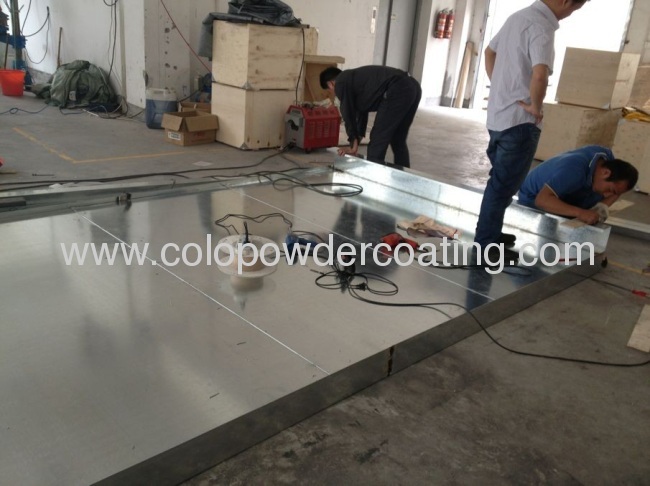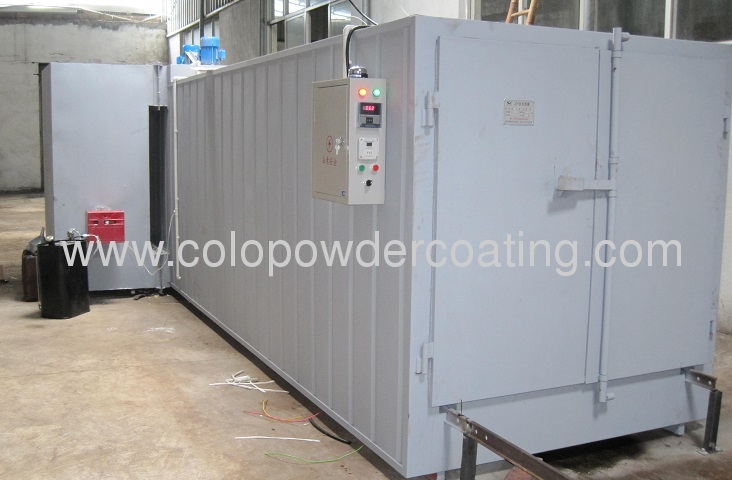


|
Hangzhou Color Powder coating Equipment co.,ltd
|
| Payment Terms: | T/T |
| Place of Origin: | Zhejiang, China (Mainland) |
|
|
|
| Add to My Favorites | |
| HiSupplier Escrow |
Using a magnifier, determine if the contaminant is under or on top ofthe coating. If it is under the coating, then the contamination wasintroduced before or during the application of the coating. If thecontaminant is on top of the coating, then it was introduced after theapplication of the coating. If the contaminant is easily removed fromthe coating by brushing the surface, then the contaminant was introducedafter the coating has set-up, which means after the coating was cured.
Contaminants for the conveyor carriers, chain, etc. can be removed usingconveyor cleaning systems available from several manufacturers (look atPF ONLINE under conveyor lubricators and cleaners). These devicesshould be located before the conveyor lubrication system and immediatelyahead of the pretreatment system to remove any debris that falls ontothe parts. While on the subject of conveyor lubrication, you must use ahigh-temperature lubricant to ensure that this material doesn't burn inthe cure oven and add to your contamination problem. Select a lubricantthat will withstand 500F or higher, if required.
Ash on the parts is caused when powder coatings are blown from theparts and hangers into the oven airstream or by contaminants enteringthe oven from the plant airspace that have catalyzed or burned.Adjusting the velocity of the air seals or circulation air at the ovenentrance will reduce the problems of blowing the powder coating from theparts and/or the hangers. A little known cause of this phenomenon ispoor part grounding. If the part is improperly grounded, then theelectrostatic force that holds the powder onto the part's surface islower. The lower the electrostatic force, the more likely the powdercoating will be displaced by the oven airstream. Frequent hangercleaning and conveyor maintenance will improve the ground (less than 1megohm resistance) and eliminate this as a cause to your contamination problem.
If you are sucking airborne contaminants into your oven from theplant airspace, then you must isolate their sources or use filters toremove them. Filtration is available to clean air that is introduced bythe combustion blower in convection ovens. These filters are locatedoutside the oven and do not have to be high-temperature resistant.Isolating the cure oven from your plant airstream may be required toprevent airborne contaminants from entering the part entrance/exit ofthe oven. Walling off the oven and providing an outside air supply willsufficiently isolate your oven from the dirty plant airspace. However,isolating the specific plant area that is causing the contamination maybe easier than isolating the cure oven.
Last, check your oven exhaust turnover rate. It should be between4-12 air changes per hour. Adjusting this is tricky, since too littleair will allow more time for the contaminants to catalyze and too muchair will introduce more airborne plant contaminants. Furthermore, thelimits on oven exhaust are regulated by NFPA codes. Always consult youroven manufacturer to determine these limits before making any changes.
Enough about the causes of contamination, let's talk about thecorrective action necessary to remove contamination in the cure oven.Normal oven maintenance requires monthly cure oven cleaning. Cleaningyour oven more frequently may be required if you cannot get control ofthe contaminants or have a higher than average surface qualityrequirement. Cleaning is accomplished by vacuuming all surfaces cleanand following with a damp mop. Be sure to clean all surfaces includinginside the ductwork, if possible. Do not use water to clean the ovenunless your oven was designed to be watertight and has a floor drain. Amop dampened in water will not cause any problems, as long as you wringit out good and clean it frequently. Using tack rags or otherimpregnated devices can add to your contamination problem, since theyleave traces of the impregnated material on the oven surfaces. Thesematerials will eventually catalyze and end up as ash on your parts.
Remember, it is always best to stop the sources of the contaminationthan to implement plans to collect the debris after it has entered thecure oven. Also, remember that you must perform monthly cure ovencleaning as part of a preventive maintenance program.